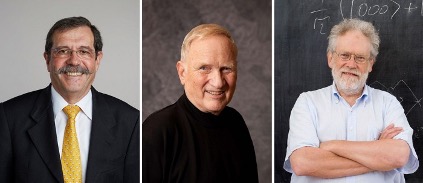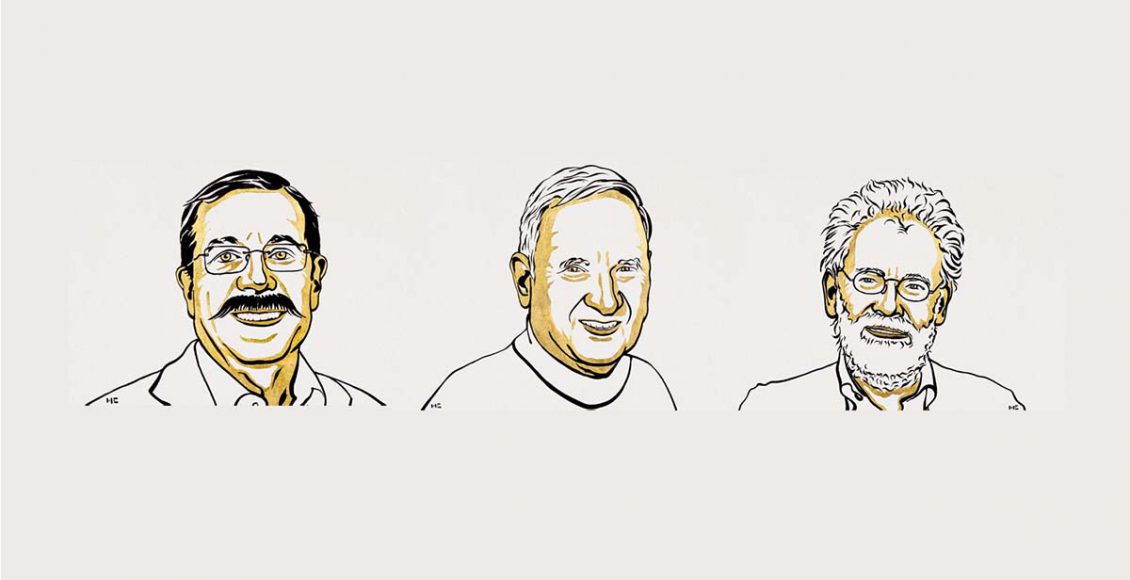The 2022 Nobel Prize in Physics
Entanglement: Gateway to the new age computing
Dr. Rakesh Mohan Das
Assistant Professor, Department of Physics, School of Applied Science
The 2022 Nobel Prize for Physics has been awarded to Alain Aspect (France), John Clauser (USA), and Anton Zeilinger (Austria) for their pioneering contribution in the foundation of quantum computing technology. The history of computer goes back to early 19th century. Charles Babbage designed the first mechanical computer, The Babbage Difference Engine, in 1822 which could compute simple calculations. In 1946, the University of Pennsylvania in the US built a computer using vacuum tubes. The computer was so large that the vacuum tubes occupied the entire building. Besides, it consumed a huge amount of electricity and exhausted a lot of heat. The birth of semiconductors marked the soaring growth of computer. The history goes back to the invention of the rectifier (AC-DC converter) in 1874. Decades later, John Bardeen and Walter Houser Brattain at Bell Laboratories in the US invented the point-contact transistor in 1947, and William Shockley invented the junction transistor in 1948. This heralded the arrival of the transistor era. Development of transistors and other semiconductor-based devices led to the boom in electronics. It enabled computers to handle advanced level computation, become more energy efficient and compact in size. The Nobel Prize in Physics in 1956, was awarded jointly to Shockley, Bardeen and Brattain for their contribution in the research and development of semiconductors and transistors which are the building block of modern age computer. And it goes without saying, how far we have come in a matter of five decades and how immensely computers have revolutionized the world in each and every aspect of life.
And now, we are exactly in a similar juncture of time of another leap in computing. The year of 2022 has witnessed the reoccurrence of the reckoning of a promising future in the field of information processing with this year’s Nobel Prize in Physics being jointly awarded to Alain Aspect, John Clauser, and Anton Zeilinger for their contribution in the foundation of quantum computing technology.
Quantum Computing in a nutshell
Deep inside the matter at the near-atomic or subatomic level, systems can no longer be deterministically described by the Newton’s law as in the macroscopic world. They are described by the principle of quantum mechanics. In this regime, quite remarkable phenomena come into play such as superposition, interference and entanglement. The principle of superposition and interference are familiar phenomena in classical waves, with the only difference that the amplitude in the case of quantum mechanical systems is the amplitude of probabilities. Quantum computing harnesses these exotic properties at the subatomic level and applies them to information processing. In a classical computer, the element of information is a bit which can have two states which are encoded as 0 or 1. All the complex operations are based on binary digit system which relies on the collection of bits. Analogous to the classical bit, a quantum computer is based on the element which is called quantum bit or qubit. Quantum systems which have two possible states such as a proton with two spin states or a photon with two polarization states are implemented as qubits. A qubit can be in a superposition of the 0 and 1 states. This property can be used to the advantage of parallel computational operations at the elementary level which makes a quantum computer exponentially faster than a classical computer in certain classes of operations. The property of entanglement is completely unique, and this gives a quantum computer ability which a classical computer is oblivious to. In short, entanglement is the phenomenon of correlation of two particles or physical systems without any local connection. Entanglement is more intriguing which needs a rather extensive elaboration. This phenomenon had nonplussed the scientists including Albert Einstein for a long time and the 2022 Nobel Prize in physics is the culmination of the scientific breakthroughs in practical realization of entanglement.
Entanglement: A closer look
Let us consider a hypothetical pair of balls each one of whose surfaces are painted black on one hemisphere and red on the other. The two balls are somehow connected by a rotatable shaft which constrains them so that if the first ball faces black then the second ball faces red and vice versa. The moment we observe the first ball facing black, we know that the other ball is facing red. There is no need of a process of observing the second ball to find out that it is facing red. We just know it instantly from observing the first ball. The two balls are locally correlated, howsoever long the shaft may be. Similarly, consider that you checked in to a hotel and found out one of a blue and a red pair of socks after opening your suitcase. That just instantaneously makes you realize that you haven’t brought the right pairs. The other blue and red socks are lying inside the closet at home far away. In the two examples above, no information has been passed from the other side. The information was right there with you all the while by the virtue which is known as local realism which is manifested in the shaft in the first example and you, being the carrier of information who travelled, in the second example.
Analogically, coming to the subatomic level, where quantum principles stay at the helm of dynamics, the indeterminacies of the observable related to two subsystems far apart, are correlated. The only difference is that they are non-local in nature. A pair of photons which have correlated polarization will continue to have same set of polarization, howsoever far apart they are. In principle, if we measure the polarization of a photon along a certain direction, that of the other photon will collapse to the polarization along a certain correlated direction. This phenomenon is known as quantum entanglement. That is where Einstein had problem in. How can there be no apparent instrument of correlation like there are in the above two classical examples we considered? In fact, these non-local connections predicted by quantum mechanics was originally pointed out by Einstein and his students, Podolsky and Rosen (famously known as EPR), but they used it to argue that quantum mechanics must be incomplete – dismissing the possibility of such ‘spooky action-at-a-distance’ out of hand. However, in 1964, John Bell, an Irish physicist, published a now-famous paper arguing that any theory of quantum physics must abandon the notion of Einsteinian locality (or causality i.e. the requirement that no influence can travel faster than light), and objective reality of the properties of subatomic particles. So, does entanglement violate causality? No! Quantum entanglement is not a cause and effect phenomenon. It is a correlation which is nonlocal. That is to say, distant events, which are not causally related, are nonetheless correlated. Saying “These are two independent particles, entangled” is wrong. That is the beginning of trying to make it to be a classical phenomenon. Quantum mechanics does not talk about individual particles. It talks about system states. That’s what the wave function (or state vector) is for. This system of particles has one wave function, not two. There is therefore only one state to measure, not two. In the socks in the hotel example, the correlation was actuated by the information carried all along in the suitcase and in the ball and shaft example, it is the shaft that correlates the balls. These classical examples motivated scientists to propose the incompleteness of quantum mechanics and the existence of ‘local hidden variable’. Over the years, there has been a lot of work published to justify the existence of local hidden variable.
However, Bell’s theorem established that the correlation between distant events is manifestly nonlocal and put the conundrum to an end. He derived an inequality by a probabilistic approach of measurement of an observable of correlated particles based on local realistic principle. The inequality will be violated if the system is described by the principle of quantum mechanics and nonlocality. The year of 2022 celebrates this experimental verification and scope of revolutionary applications of the novel phenomenon of entanglement by awarding Aspect, Clauser, and Zeilinger, this year’s Nobel Prize in Physics. They successfully designed and performed experiments that tested some of the most counterintuitive predictions of quantum mechanics. In 1972 Clauser and Stuart Freedman tested the local hidden-variable theories by generating pairs of entangled photons and analyzing the measured polarizations of the particles. By plugging the correlations between measurements into the Bell’s inequality, Clauser experimentally verified that the result was inconsistent with the principle of local realism. In the early 1980s, Aspect (Université Paris–Saclay and École Polytechnique in France) and his colleagues reinforced Clauser’s findings with more robust experimental setups. Zeilinger is one of the pioneers in the flourishing field of quantum information science. He and his colleagues have demonstrated quantum teleportation, entanglement swapping, and other quantum state manipulation techniques that are essential for the development of quantum computers, communication networks, and cryptography schemes.

Figure 1. Alain Aspect, John F. Clauser and Anton Zeilinger (from left to right)
What lies beyond for KIIT
The field of quantum computing is one of the most promising fields of the present. It is bound to revolutionize the future of computing and it holds the key to many scientific discoveries in all fields. The recent Nobel prize in physics is live evidence of it. Leading companies such as IBM, Amazon and Google are already running primitive quantum computing hardware which scientists and researchers can avail through cloud to develop and deploy their quantum algorithms useful in many fields. The School of Applied Science at KIIT University has already begun working in this field. The School has already floated an elective course on quantum computing for BTech students. It is a very appropriate time for KIIT to set up a dedicated computing facility in the Central Research Facility for research in quantum computing which will promote interdisciplinary research work inside KIIT, kick start the involvement of enthusiastic BTech students in research work in this field, which has immense industrial and market value. KIIT cannot afford to miss the fast-moving bandwagon of quantum computing.


